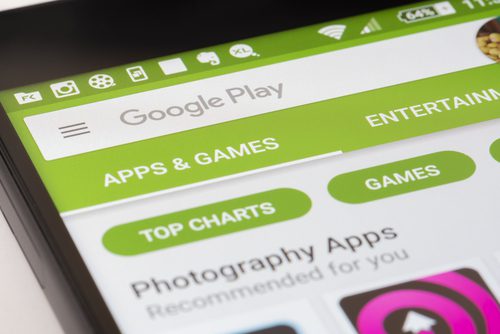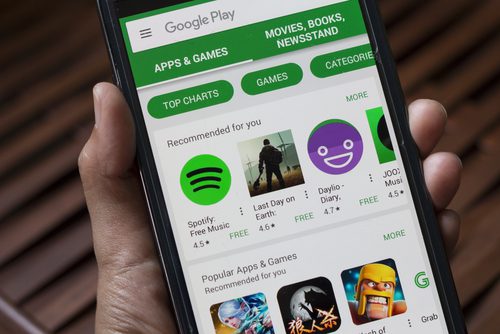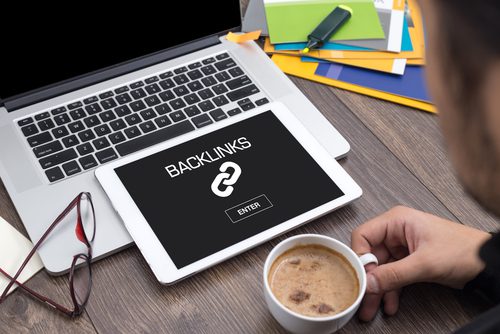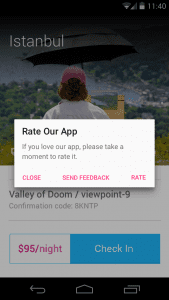
A Step-by-Step Guide for Driving Android App Downloads
As the novelty of smartphones wore off, Android app downloads started plummeting too.
Here’s a quick refresh: an app download happens whenever a software or a mobile application is transferred, usually from the Google Play Store, and run on a mobile device such as a phone, tablet, or watch. Driving Android app downloads involves strategically using keywords, doing A/B testing, getting backlinks to an app, and focusing on accumulating more positive app store reviews.
There are currently about 2.6 millions apps on Google Play and 2.2 million on the App Store. When given so many choices, consumers tend to develop “option paralysis” and stick to a handful of favorite apps they already have in their phones.
Many users go months without downloading any new apps. In fact, over 50% of apps in the Google Play Store fail to get even one download and of the apps that receive decent download numbers, 80% drop off in the first week, according to recent data.
Even if your research is on point and you built the app your ideal audience was looking for, you might still fail to market your app properly. However, there is one thing that you can do to get your Android app into the palms of users everywhere.
Enter Google Play App Store Optimization Strategies (ASO).
Here is an easy 4 step plan that will help you optimize your Android App on Google Play:
- Optimize the keywords you are trying to rank for
- A/B Test your creatives
- Increase backlinks to your app.
- Increase the number and quality of ratings & reviews for your app
Step 1: Optimize your app’s keywords
The key to keyword optimization is diligent research: look at your competitors, investigate what your users are searching for and optimize your app copy to reflect the needs of your ideal customers.

The first step to optimizing anything on the web -- whether it’s a website or an app -- is to research, analyze, and select the keywords that will drive quality traffic from search engines to your site and mobile app.
Keyword optimization is important because the right keywords put your app’s landing page at the top of the user’s search results.
When searching for new apps, your users often start out with non-branded search terms because they won’t necessarily know the name of your app.
When mobile users are looking to discover new apps, they use descriptive search terms to define their need or problem. Keyword optimization plays a crucial role in marketing your app because it helps users actually find your app. By targeting the most common words and phrases your customers use to solve their problem, you position your app as the primary solution to their need.
As a general rule, you need to show up in searches that are relevant to your target audience. One of the best ways to do this is to research broad keywords (also known as short tailed keywords) that your competitors rank with. Make sure you also rank for long tail keywords which are words and phrases that are relevant to your app (usually 3-4 words).

Keywords are grouped into two categories: short tail keywords and long tail keywords.
- Short tail keywords: They are broad search terms that consist of only one or two keywords. For example, if your app is a fitness app a possible short tail keyword could be “fitness app” or “weight loss app.” While you cannot reasonably expect to rank for every single one of these incredibly competitive keywords, it is important to determine which ones are most relevant to your niche. This is where good market research comes into play. Find out which words and phrases your competitors rank for, then strategically apply those to your app.
- Long tail keywords: These keywords are more targeted and specific than short tail keywords. Relating back to the fitness app example, a long tailed keyword could be “food tracking app for fitness and weight loss.” They have a lower search volume and are less competitive to rank for. According to Moz.com, users who conduct long tail keyword search are also further along in the buying cycle than users who use short tail keywords, and have the greatest chance of converting into paying customers.
[bctt tweet="As a general rule, you need to show up in searches that are relevant to your target audience." via="no"]
One more critical component in your keywords strategy: prior to keyword optimization, it is important to research your app competitors. Some free tools to leverage are Spyfu and SimilarWeb. Entering your app competitor’s domain into Spyfu or SimilarWeb will reveal all of their organic keywords.
The idea is simple: your competitors have already done extensive research into target audience they’re looking for. And if you share the same audience, you can position your app perfectly for success simply by examining your competitors’ strategy.
To get help analyzing the competitiveness of your app’s search terms, check out TheTool or AppAnnie. TheTool tracks installs and keyword rankings from 91 countries. AppAnnie tracks keyword rankings competitor data.
Bottomline: keyword optimization is the first step towards getting in front of your customers.
If your app is the solution to the problem your users are trying to solve, it is your duty to increase the likelihood that they will download -- and actually use -- your app. The key takeaway here is to think like your user when optimizing for short and long tail keywords.
Step 2: Optimize your Google Play Store page and conduct A/B testing

Optimize your app’s title and description.
The Google Play Store ranking algorithm uses three major fields when ranking apps: the app’s title, short description, and long description.
It is important to ensure the right combination of keywords appear in these fields.
According to ComboApp, the app title is one of the most important Play Store ranking factors because unlike the App Store, the Google Play Store does not have a keyword search field. This means that Google will rank the text that appears at the very top of your app title first. Consequently, your app title should include the primary keyword you want to rank for since that’s the first and most important ranking factor Google will use when showing results to Android users.
There is one more reason why your app title should include the primary keyword. According to data from Mobile Action, 82% of app store users do not look past the first 25 search results. So if by any means your app title doesn’t include the most relevant keyword, your app will never make it in front of your ideal users.
[bctt tweet="82% of app store users do not look past the first 25 search results." via="no"]
Once you figured out the perfect title for your app, you should move on to creating a robust short app description. Here, again, you are limited by the brevity expected from this field. The short description is limited to 80 characters and is what your potential user sees before clicking on Read More.
Finally, the long description has a four thousand character limit. The short description and the first paragraph of the long description are key to determining your Google Play app ranking.

To bottomline it, ranking organically in the Android App store is no small feat. Most app developers ignore the importance of this step.
Make no mistake: creating the right copy to rank organically is a real science. SEO specialists, copywriters, editors and marketers come together to create the most compelling copy out there.
If you cannot afford these resources, at least make sure you spend a considerable amount of time doing the proper research and optimizing the copy to the best of your abilities before launching the app to production.
Step 3: Optimize your visuals with A/B testing
Launching your app to the App store is not a “one and done” deal. You need to monitor how your app is performing and you need to constantly test your marketing copy and creatives. That’s where A/B testing comes in handy. A/B testing: your best friend to maximize your downloads.

Once you’ve created your app’s icon, selected the screenshots that will visually showcase what your app is about and, ideally, created a promo video highlighting the value of your app, it’s time to optimize them through A/B testing.
A/B testing is the process of optimizing various parts of an app or website in order to see if it results in different conversions for your digital product.
In the specific case of App store copy and creatives, A/B testing works by switching one element at a time in your Play Store listing. This way, you can see if users react differently to specific creatives and visuals. A/B testing helps you optimize your app to drive the highest number of downloads.
And here’s the thing. There are so many things you can optimize for with a mobile app app store listing. For Android, you can A/B test your short and long description, the header image, featured graphic and screenshots.
For example, at Digital Authority Partners we have tested screenshots by changing the image copy, the background colors or even the screenshot images themselves. There’s are so many things you can do to optimize your app listing page.
Here are our high level steps for effective A/B testing:
- Research for a reasonable testing hypothesis. Scope out your competitor’s layout in the Play Store for best practices and ideas.
- Know your target audience. What is the age, sex, and interests of your ideal user? Leverage this information with what you gathered from your competitors in the Play Store and set up testing variations.
- Follow the best practices in A/B testing. Test ONLY one variable at a time so you can distinguish what worked and what didn’t. Divide your traffic equally to the two variations. Have enough traffic to achieve statistically significant results. Run the experiment for at least one week to note behavioral changes during different days.
To conduct A/B testing systematically (very important!), you should consider using free tools like Google Experiments or SplitMetrics.
These tools allow you to run tests, collect data, and determine what will convince users to hit the download button. And don’t forget: ASO is a fluid process that requires continuous tracking, monitoring and repetition.
Bottomline: do not underestimate the power of A/B testing when it comes to your app listing page. You need to systematically optimize your listing to ensure you are doing everything you can to attract the widest number of downloads.
Step 4: Increase backlinks to your app
You may think of your app as being entirely different from a website strategy. For Android apps, that’s not the case. In fact, links coming from other websites to your Android listing page are known to boost the overall visibility of your app in Google Play. Make sure your app strategy is tied to an overall web strategy for backlinks and digital mentions.

Here’s a little dirty secret: For Android apps only, backlinks from other websites to your Google Play listing page will also increase your Play Store ranking.
According to Apptamin, producing quality content and getting social media shares of your Play Store URL are great ways to help your app’s ranking and boost Android app downloads.
The more relevant backlinks your app has, the higher your Google Play Store ranking.
To increase backlinks from other websites, start with producing quality and relevant content that points to your app. You can then link your Play Store URL to your website, blog, and social media profiles.
As an added bonus, when you produce quality content around your app, you also increase the chance of sites with greater authority linking to your Play Store URL.
This is a huge search ranking factor and will boost your Play Store ranking considerably.
Here are some ideas to consider when increasing your app’s backlinks:
- Reach out to influencers in your target niche and develop an authentic relationship with them. Buzzsumo is a free tool you can use to find influencers in any niche. Ask them to promote or review your app in exchange for featuring one of their articles on your social media or website.
- Engage with blogs that are in your app’s target niche. Leave insightful comments and, when appropriate, link to your app.
- Pitch to app review websites like AndroidTapp, AppBrain, and AndroidLib. Having your app reviewed on these sites will generate the buzz needed to drive traffic to your app.
- Connect with other app developers and entrepreneurs on social platforms like Facebook and LinkedIn. Discuss features, updates, and bug fixes. Offer to exchange reviews and give them trial codes to test out your app for free. Insert a link to your app’s website when appropriate. This is a mutually beneficial relationship for both parties involved.
Bottomline: Backlinks to your mobile app Android listing page are critical to your app store rank. After all, Google is simply applying the same logic to Google Play ranking as they do for all relevant web content when you search for anything on Google. That means you need to be smart about your overall content and outreach strategy.
Don’t think of your mobile app rating in isolation from your web strategy. Make sure you create a one page web landing page for your app and drive traffic to both your Google Play listing page and your website if your app is to stand out from the millions of apps out there.
Step 5: Increase the number of Ratings and Reviews
Ratings & Reviews play a crucial role in your overall app rank. That applies to both frequency of reviews (getting reviews on a monthly basis) and quality of reviews (details of reviews and the rating itself). Make sure you encourage users to leave a review in Google Play after they’ve used your app a few times.

Last but not least, make the Google Play ranking algorithm work for you by increasing the number of app reviews for your app.
While there is no exact way to calculate the complex algorithm that Google uses to rank apps, considerable evidence points to ratings and reviews playing a crucial role in determining your overall ranking for specific keywords.
According to data by Apptentive, jumping from a 1-star app rating to a 5-star rating produces a whopping 770% increase in download numbers. On the same note, jumping from a 2 or 3-star app to a 5-star rated app on Google Play can increase App Store conversion by up to 570% or 97%, respectively.
You should also consider the following statistics: about 80% of people read an app review before downloading it, and 50% consider app reviews to be more trustworthy than personal recommendations. Need we say more? When you get ratings and reviews, you get app downloads! Read on for some tips on how to increase your reviews.
[bctt tweet="70% of people read an app review before downloading it, and 42% consider app reviews to be more trustworthy than personal recommendations." via="no"]
But before you continue, beware: The sad truth is that most people will either love or hate your app. Make sure you have it quality tested to remove all bugs.
This article assumes you have a good app on hand but still need to effectively execute ASO.
So what’s the best strategy to make sure ratings and reviews work in your favor? It’s simple: ask for reviews.
A typical strategy to ask for reviews from existing users is the pop-up review request. This is a window that pops up in-app and solicits a review from your user.

However, be mindful to not annoy your user. Consider showing a pop-up only if your users have opened your app a set number of times, or after your app has successfully delivered on what it was designed to do. You remember our earlier example of a fitness mobile app? In that scenario, the app developer should only ask for a review if their user opened the app more than three times in a day or if it successfully logged the nutrition information of a food item for them.
Additionally, you may consider integrating your request for an app review directly within the app itself, or within its app description. This way, it is entirely up to users to decide if they want to leave a review.
Bottomline: reviews are important to the overall app ranking in search results. Ratings and reviews tell your potential users that an app is worth downloading, and alerts the developer to any areas of improvement. Make sure you devise a strategy to encourage users to constantly help other users find your app by providing both praise and constructive criticism to your app.
Summary:
To sum up, proper ASO requires 4 key processes to happen simultaneously: keyword optimizations, A/B testing, increasing backlinks to your app and increasing the number of app ratings & reviews.
Here’s a summary of what we learned today:
Optimize your keywords: Because the app title is the first place where keywords typically appear, it is essential to define the primary keyword you want to rank for. In addition, the short description and first paragraph of the long description are critical when it comes to proper app store optimizations techniques. Additionally, proper market research is key to determining the right short and long tailed keywords your app should rank for.
Optimize your Play Store presence with A/B testing: Researching your competitors’ visuals in the Play Store falls under standard market research. Without researching what your competitors are doing (or even researching best apps that rank across different categories, not necessarily your own), there is no basis for a good A/B testing hypothesis. A/B test your short/ long description and all your visual creatives for best results.
Increase the number of backlinks to your website: consider investing in finding the right influencers for your app and engaging with others in the app development or app review communities to help increase the backlinks to your app and website.
Actively ask your current users to rate and review your app: Soliciting app ratings and reviews is instrumental to achieving high Play Store rankings. Just make sure you ask for reviews at the right time and that you wait until your users actually use the app enough to avoid annoying them with your request.
By leveraging the tips in this article, we are confident that you will be able increase the downloads of your app. Now it’s your turn: we genuinely hope you’ll be able to shine in the Google Play Store and that your found our advice actionable and helpful.
Need help marketing your app or want to learn how we can take your app from ideation to marketing? Contact us for a FREE 30 minute consultation. Or call us at 312-820-9893.
Want To Meet Our Expert Team?
Book a meeting directly here





